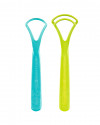

































 Swiss premium oral care
Swiss premium oral care
 United Arab Emirates
United Arab Emirates

Clean your tongue
Variants
Clean your tongue

Variety of scraper styles

Suitable for different needs

Hygienic storage case

Variety of scraper styles

Suitable for different needs

Hygienic storage case
Gently scrape your tongue once a day to easily remove bacteria and other deposits. Say goodbye to bad breath.
A CTC tongue cleaner is amazingly successful against halitosis. Its anatomically correct shape reduces nausea and its effect can be seen and smelled. Success from the first time you use it.
Twin pack: tongue cleaner single-bladed and double-bladed
Bad breath can come from bacterial coatings on the tongue, in the tongue fissures, as well in the interdental spaces. The CTC tongue cleaner is amazingly successful. Its anatomically correct shape reduces nausea and its effect can be seen and smelled. Success from the first time you use it.
 Swiss premium oral care
Swiss premium oral care

